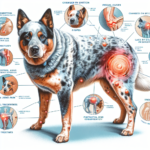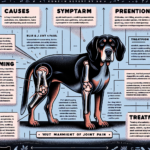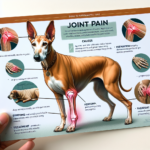Drever Joint Pain: Causes, Symptoms, Prevention, and Treatment

Introduction
Overview of Drever: The Drever is a small, robust hunting dog originating from Sweden. Known for its exceptional tracking abilities, the Drever was developed in the early 20th century by crossing the Westphalian Dachsbracke with other local hounds. This breed is characterized by its long body, short legs, and a keen sense of smell, making it an excellent choice for hunting small game like deer and hare. Drevers are also known for their friendly and even-tempered nature, making them great companions for families.
General Health Concerns: Like many breeds, Drevers are prone to certain health issues. Common concerns include ear infections, obesity, and dental problems. However, one of the most significant health issues that Drever owners should be aware of is joint pain, which can severely impact the dog’s quality of life.
Importance of Joint Health in Drever: Joint health is crucial for Drevers due to their active lifestyle and hunting background. Healthy joints are essential for maintaining their mobility, agility, and overall well-being. Given their predisposition to joint issues, proactive measures are necessary to ensure a long, healthy life for these dogs.
Breed-Specific Joint Pain Risks
Genetic Predisposition
Drevers, like many other breeds, have a genetic predisposition to joint-related issues. Common conditions include hip dysplasia, elbow dysplasia, and arthritis. Hip dysplasia occurs when the hip joint doesn’t fit properly into the hip socket, leading to pain and mobility issues. Elbow dysplasia involves abnormal development of the elbow joint, causing lameness and discomfort. Arthritis, a degenerative joint disease, can also affect Drevers, particularly as they age.
Age-Related Risks
As Drevers age, the risk of developing joint pain increases. Typically, signs of joint issues may start to appear around middle age, which for Drevers is around 5-7 years old. However, some dogs may show symptoms earlier, especially if they have a genetic predisposition or have experienced joint injuries.
Activity Level and Joint Stress
Drevers are active dogs that require regular exercise to stay healthy. However, their high activity level can also contribute to joint stress, particularly if they engage in high-impact activities like jumping or running on hard surfaces. Hunting, which involves a lot of running and sudden movements, can also put additional strain on their joints.
Common Symptoms of Joint Pain in Drever
General Symptoms
Owners should be vigilant for common symptoms of joint pain in their Drevers. These symptoms include:
- Limping: A noticeable limp or favoring one leg over another.
- Stiffness: Difficulty in getting up or lying down, especially after rest.
- Reluctance to Move: Hesitation or refusal to engage in physical activities they once enjoyed.
- Swelling: Visible swelling around the joints.
- Behavioral Changes: Increased irritability or signs of discomfort when touched.
Breed-Specific Symptoms
In Drevers, joint pain may manifest in specific ways due to their unique body structure. For instance, their long bodies and short legs can make them more prone to back pain and spinal issues. Owners should watch for signs of discomfort in the back or spine, such as arching the back or sensitivity to touch in that area.
When to Consult a Vet
If you notice any of the above symptoms in your Drever, it’s essential to consult a veterinarian promptly. Early diagnosis and treatment can significantly improve the dog’s quality of life and prevent further joint damage.
Preventive Measures for Joint Health
Exercise Recommendations
Regular exercise is crucial for maintaining joint health in Drevers. However, it’s essential to choose low-impact activities that minimize joint stress. Recommended exercises include:
- Walking: Daily walks on soft surfaces like grass or dirt trails.
- Swimming: An excellent low-impact exercise that strengthens muscles without stressing the joints.
- Controlled Play: Gentle play sessions that avoid excessive jumping or sudden movements.
Dietary Suggestions
A balanced diet rich in essential nutrients can support joint health. Consider incorporating the following into your Drever’s diet:
- Glucosamine and Chondroitin: Supplements that help maintain cartilage health.
- Omega-3 Fatty Acids: Found in fish oil, these can reduce inflammation and support joint health.
- Antioxidants: Foods rich in antioxidants, like berries and leafy greens, can help reduce inflammation.
Weight Management
Maintaining a healthy weight is crucial for reducing joint stress. Overweight Drevers are at a higher risk of developing joint issues. Regular exercise and a balanced diet can help keep your dog at an ideal weight. Consult your veterinarian for specific weight management guidelines tailored to your Drever.
Early Screening and Monitoring
Early screening for joint issues can help catch problems before they become severe. Regular veterinary check-ups, including X-rays and physical exams, can identify early signs of joint problems. Genetic testing can also help determine if your Drever is predisposed to specific joint conditions.
Treatment Options for Joint Pain
Non-Surgical Treatments
Several non-surgical treatments can help manage joint pain in Drevers:
- Medications: Anti-inflammatory drugs and pain relievers can reduce pain and inflammation.
- Physical Therapy: Exercises and therapies designed to strengthen muscles and improve joint function.
- Lifestyle Adjustments: Modifying activities to reduce joint stress and incorporating rest periods.
Surgical Options
If joint pain becomes severe, surgical interventions may be necessary. Common surgical options include:
- Joint Replacement: Replacing a damaged joint with an artificial one.
- Arthroscopy: A minimally invasive procedure to clean out the joint and remove damaged tissue.
- Osteotomy: Cutting and realigning bones to improve joint function.
Alternative Therapies
Alternative treatments can also benefit Drevers with joint pain:
- Acupuncture: Using needles to stimulate specific points on the body to relieve pain.
- Hydrotherapy: Water-based exercises that reduce joint stress while improving strength and mobility.
- Massage: Gentle massage can improve circulation and reduce muscle tension around the joints.
Lifestyle and Management Tips
Daily Care Routine
A consistent daily care routine can help manage joint pain in Drevers. A sample routine might include:
- Morning: A short walk on a soft surface, followed by a gentle stretching session.
- Midday: A rest period with access to a comfortable, orthopedic bed.
- Afternoon: A low-impact play session or swim.
- Evening: Another short walk and a gentle massage to relax muscles.
Modifying the Home Environment
Making your home more comfortable for a Drever with joint pain can significantly improve their quality of life. Consider the following modifications:
- Ramps: Install ramps to help your dog navigate stairs or get onto furniture without jumping.
- Orthopedic Beds: Provide a supportive bed that reduces pressure on the joints.
- Non-Slip Flooring: Use rugs or mats to prevent slipping on hard floors.
Long-Term Management
Long-term management strategies are essential for keeping your Drever active and happy despite joint pain. These strategies include:
- Regular Vet Check-Ups: Frequent veterinary visits to monitor joint health and adjust treatments as needed.
- Consistent Exercise: Maintain a regular exercise routine tailored to your dog’s abilities.
- Ongoing Weight Management: Continue to monitor and manage your dog’s weight to reduce joint stress.
FAQs About Drever and Joint Pain
What are the early signs of joint pain in Drevers?
Early signs include limping, stiffness, reluctance to move, and behavioral changes such as irritability or sensitivity to touch.
Can joint pain in Drevers be prevented?
While genetic predispositions can’t be changed, preventive measures like regular exercise, a balanced diet, weight management, and early screening can help reduce the risk and severity of joint pain.
Are there specific exercises that are better for Drevers with joint pain?
Low-impact exercises like walking on soft surfaces, swimming, and controlled play are ideal for Drevers with joint pain.
What dietary supplements can help with joint health in Drevers?
Supplements like glucosamine, chondroitin, and omega-3 fatty acids can support joint health and reduce inflammation.
When should I consider surgery for my Drever’s joint pain?
Surgery should be considered if non-surgical treatments are ineffective and the dog’s quality of life is significantly impacted. Consult your veterinarian for a thorough evaluation and recommendations.
Conclusion
Joint pain is a significant concern for Drevers, but with proactive measures, it can be managed effectively. Regular exercise, a balanced diet, weight management, and early screening are crucial for maintaining joint health. If joint pain does develop, various treatment options, including medications, physical therapy, and surgery, can help alleviate discomfort and improve quality of life. By staying vigilant and consulting with your veterinarian regularly, you can ensure your Drever remains active, happy, and healthy for years to come.




